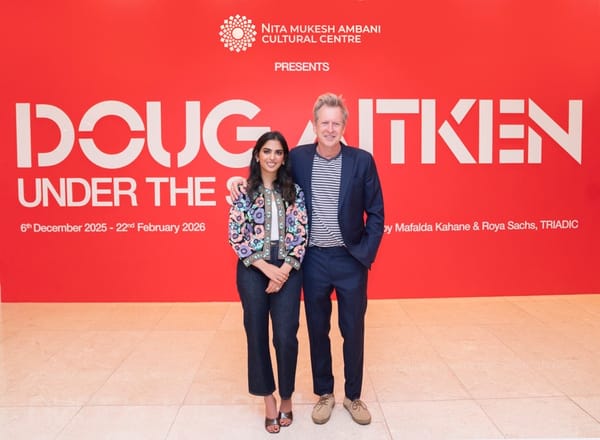A Guide to Indian Folk Art Forms
Discover the vibrant world of Indian folk art, from Madhubani's intricate patterns to Warli's minimalist charm, each art form reflecting the diverse cultural heritage and traditional craftsmanship of India's rich history.

India, a land of rich cultural diversity, is home to an array of traditional art forms that have been passed down through generations. These folk art forms are not just creative expressions but also a reflection of the country’s diverse history, traditions, and social fabric. From the intricate patterns of Madhubani to the minimalist charm of Warli, each art form tells a unique story deeply rooted in the cultural and geographical context of its origin. This guide provides an overview of some of the most significant folk art traditions across India, exploring their techniques, themes, and cultural significance.
The Cultural Landscape of Indian Folk Art
Indian folk art is as varied as the country itself. Every region boasts its own distinctive style, shaped by local customs, rituals, and beliefs. Unlike classical art, which was often patronized by the elite, folk art is an expression of the common people, created by artisans who often remain anonymous. These art forms are intertwined with daily life, religious practices, and community celebrations, making them integral to the social fabric of the regions they come from.
Folk art is created using locally available materials, ensuring its sustainability and ecological compatibility. It often serves practical purposes, such as decorating homes or creating ritualistic objects, while also preserving the cultural heritage of the communities that practice it.
Madhubani Painting: The Vibrant Art of Mithila
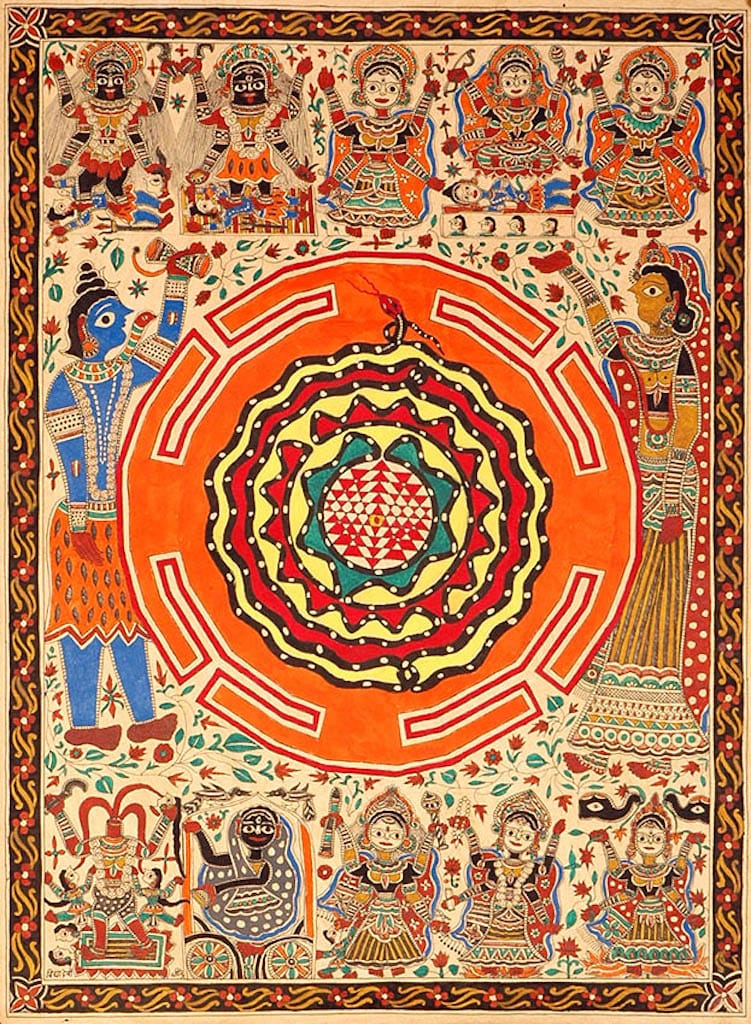
Origin and Cultural Context: Madhubani painting, also known as Mithila art, hails from the Mithila region of Bihar. Traditionally practiced by women, this art form is closely linked to religious rituals and social ceremonies, often depicting scenes from Hindu mythology.
Techniques and Materials: Madhubani paintings are known for their intricate patterns and vibrant colours, derived from natural sources such as turmeric, indigo, and vermilion. The paintings are typically created on handmade paper, cloth, or directly on walls, using bamboo sticks or fingers to apply the colours.
Themes and Motifs: Common themes include Hindu deities like Krishna and Rama, along with nature-inspired motifs like birds, animals, and trees. The entire surface of the artwork is filled with detailed designs, leaving little empty space, a characteristic feature of Madhubani art.
Cultural Significance: Madhubani paintings are not just decorative; they are an important cultural practice that brings communities together, especially during festivals and celebrations. The art form has gained international recognition and is now a symbol of India’s rich folk heritage.
Warli Painting: The Minimalist Art of the Warli Tribe
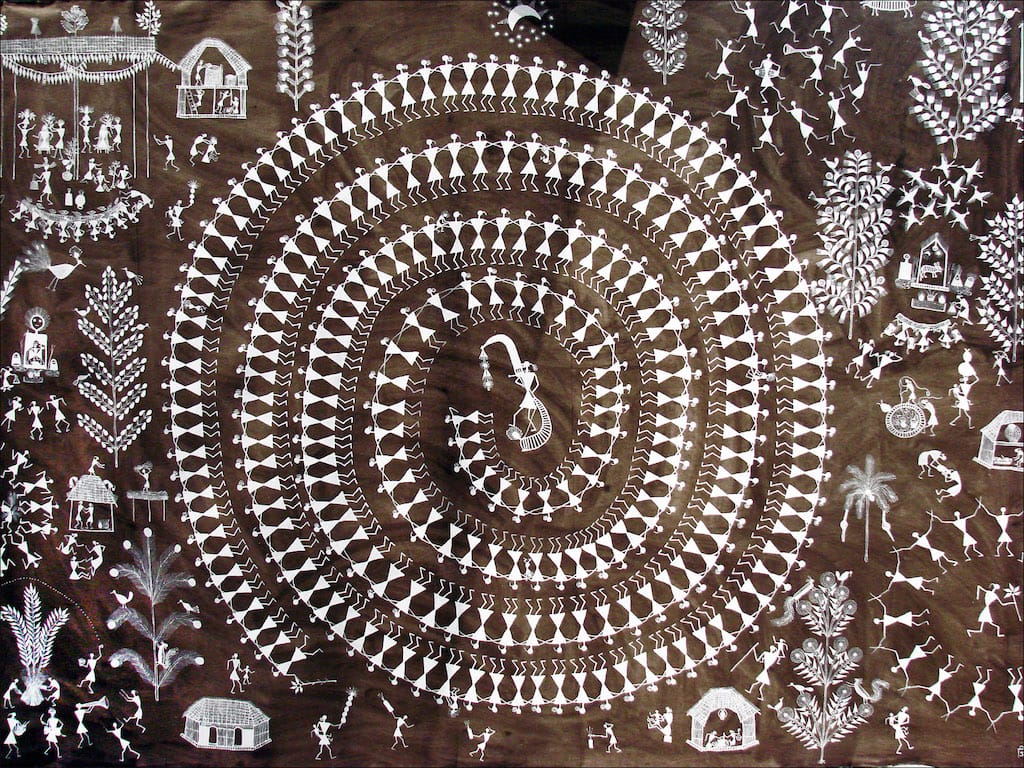
Origin and Cultural Context: Warli art originates from the Warli tribe in Maharashtra and is one of the oldest forms of Indian folk art. Unlike other colourful folk arts, Warli paintings are known for their stark simplicity, using white pigment on a red ochre background.
Techniques and Materials: The white pigment, made from rice paste, is applied using a bamboo stick on a background created from cow dung and mud. The paintings are typically done on the walls of tribal homes, depicting everyday life and social activities.
Themes and Motifs: Warli art features basic geometric shapes like circles, triangles, and squares to depict human figures, animals, and nature. The tarpa dance, where figures form a chain around a central musician, is a recurring motif, symbolizing community unity.
Cultural Significance: Warli paintings are deeply rooted in the tribe’s rituals and traditions, often created to mark significant events like weddings and harvests. Despite its simplicity, Warli art conveys profound meanings, celebrating the harmony between humans and nature.
Pattachitra: The Scroll Paintings of Odisha
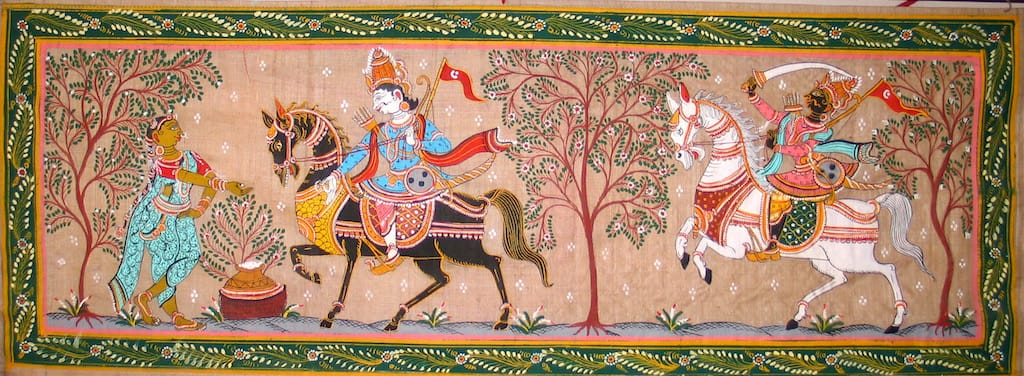
Origin and Cultural Context: Pattachitra, meaning ‘cloth painting,’ is a traditional art form from Odisha, known for its elaborate and colourful depictions of mythological themes, particularly those related to Lord Jagannath.
Techniques and Materials: Pattachitra artists use natural pigments made from minerals and plants to create vivid, flat compositions without shading. The paintings are typically done on cloth or dried palm leaves, with a base prepared using chalk and gum.
Themes and Motifs: Pattachitra commonly features scenes from Hindu epics like the Ramayana and Mahabharata, as well as local legends. The intricate borders and central figures are hallmarks of this art form, often reflecting the religious devotion of the artists.
Cultural Significance: Closely associated with the Jagannath cult, Pattachitra plays a significant role in the religious life of Odisha. The art form is preserved by generations of Chitrakars, who continue to practice this tradition with the same dedication as their ancestors.
Kalamkari: The Pen Work Art of Andhra Pradesh
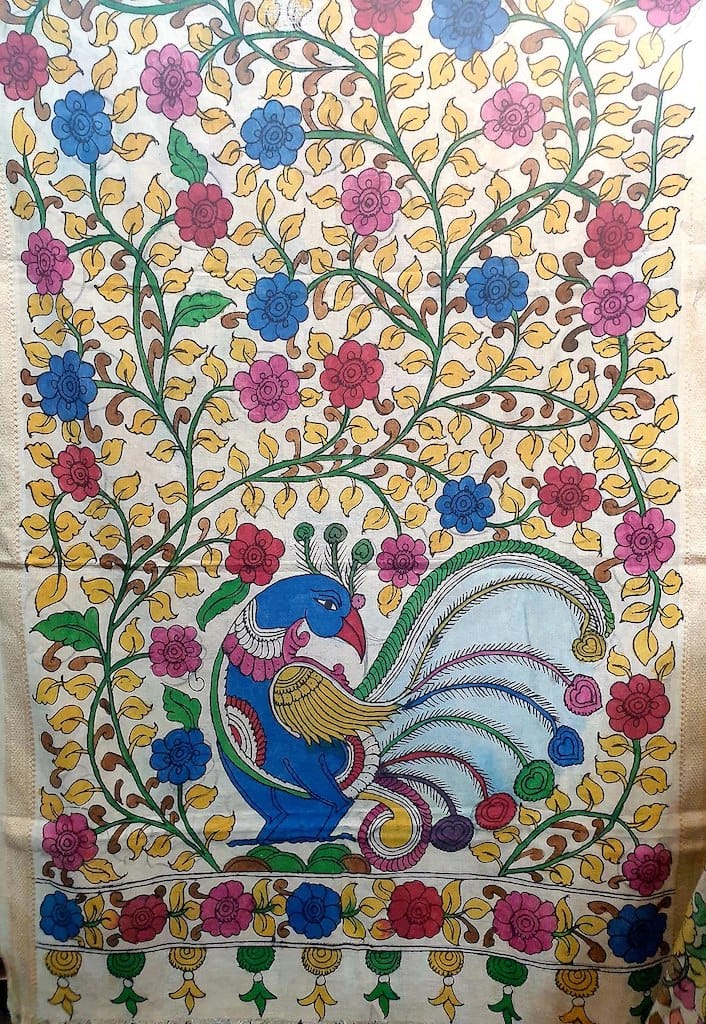
Origin and Cultural Context: Kalamkari is a textile painting tradition from Andhra Pradesh and Telangana, named after the ‘kalam’ or pen used to create intricate designs. This art form has two distinct styles: the Machilipatnam style, influenced by Persian motifs, and the Srikalahasti style, focused on Hindu mythology.
Techniques and Materials: The process involves treating fabric with natural dyes and drawing the designs using a bamboo or date palm stick. The colours, derived from various plants and minerals, are applied in layers, creating rich and vibrant textiles.
Themes and Motifs: Kalamkari designs often depict scenes from the Ramayana, Mahabharata, and Puranas, along with floral and geometric patterns. The Machilipatnam style features more abstract motifs, while the Srikalahasti style is more narrative.
Cultural Significance: Kalamkari has been an important part of India’s textile heritage, with the painted fabrics used for wall hangings, sarees, and other decorative items. The art form is celebrated for its detailed pen work and the use of natural dyes.
Gond Art: The Tribal Art of Central India

Origin and Cultural Context: Gond art comes from the Gond tribe of Madhya Pradesh, known for their rich folklore and deep connection with nature. The art form is a vibrant expression of the tribe’s spiritual beliefs and their reverence for the natural world.
Techniques and Materials: Gond paintings are created using natural pigments and are characterized by intricate patterns made up of dots, lines, and dashes. Traditionally, these paintings were done on the walls and floors of homes, but they are now also created on paper and canvas.
Themes and Motifs: The themes of Gond art revolve around nature, with animals, birds, trees, and natural elements being the primary subjects. These motifs are often depicted in a stylized manner, with an emphasis on pattern and rhythm.
Cultural Significance: Gond art is not only a visual treat but also a medium for storytelling. The paintings often narrate the myths and legends of the Gond community, making them a vital part of India’s tribal art tradition.
Phad Painting: The Epic Narratives of Rajasthan

Origin and Cultural Context: Phad painting is a traditional scroll painting style from Rajasthan, known for its epic narratives of local deities such as Pabuji and Devnarayan. These paintings are used by traveling priest-singers, called Bhopas, who narrate the stories through song and dance.
Techniques and Materials: Phad paintings are created on long cloth scrolls using natural dyes. The artists use bright colours and intricate detailing to bring the stories to life, with each scroll serving as a portable temple.
Themes and Motifs: The paintings depict scenes from the lives of the deities, with a focus on their heroic deeds and divine interventions. The compositions are filled with figures, animals, and landscapes, arranged in a narrative sequence.
Cultural Significance: Phad painting is not just an art form but also a ritualistic practice that plays a crucial role in preserving the oral traditions of Rajasthan. The art form has been passed down through generations, with families of artists dedicating their lives to this craft.
Saura Painting: The Tribal Art of Odisha
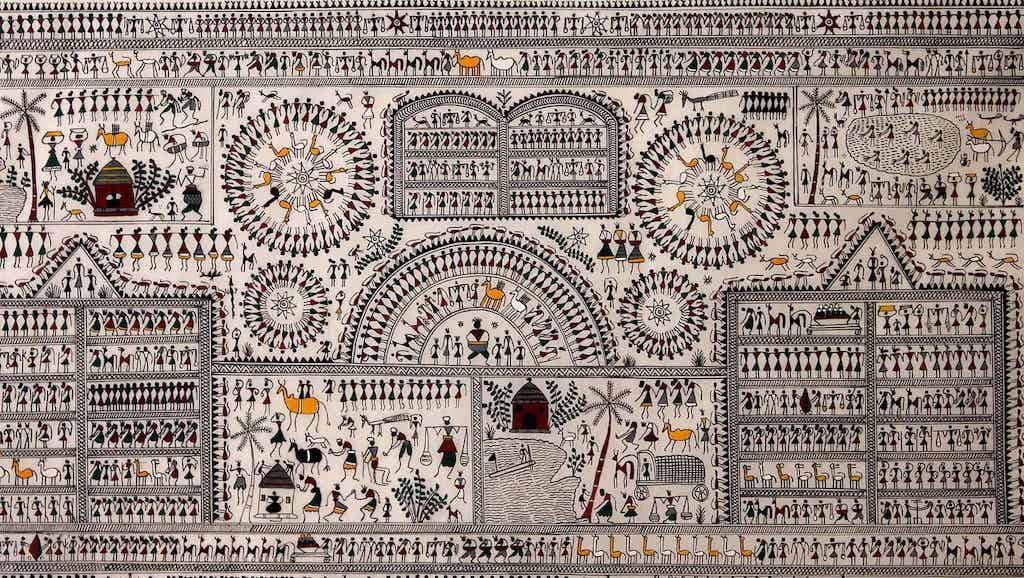
Origin and Cultural Context: Saura painting originates from the Saura tribe of Odisha and bears a resemblance to Warli art. It is a wall art form used to celebrate important events like harvests, marriages, and religious rituals.
Techniques and Materials: Saura artists use natural dyes to create paintings on the walls of their homes. The art is characterized by its use of stick-like human figures and intricate, repetitive patterns that depict daily life and nature.
Themes and Motifs: Saura paintings often depict scenes of hunting, farming, and communal life, along with religious and mythological themes. The geometric designs and stylized figures are a hallmark of this art form.
Cultural Significance: Saura paintings are deeply symbolic and are often created as part of religious ceremonies. They serve as a visual representation of the tribe’s connection to nature and their spiritual beliefs.
Chittara: The Geometric Art of Karnataka

Origin and Cultural Context: Chittara is a traditional art form from Karnataka, practiced primarily by the women of the Deevaru community. It is known for its geometric patterns and vibrant colours, used to decorate homes during festivals and rituals.
Techniques and Materials: Chittara paintings are created using natural colours derived from seeds, leaves, and stones. The designs are drawn by hand, often on the walls and floors of homes, and include motifs of flora, fauna, and everyday life.
Themes and Motifs: The patterns in Chittara art are symbolic, often representing fertility, prosperity, and protection. The designs are typically arranged in a grid-like pattern, with repetitive motifs that create a rhythmic visual effect.
Cultural Significance: Chittara art is an essential part of the social and religious life of the Deevaru community. The paintings are created during important festivals and are believed to bring good fortune to the household.
Pithora Painting: The Ritual Art of Gujarat and Madhya Pradesh
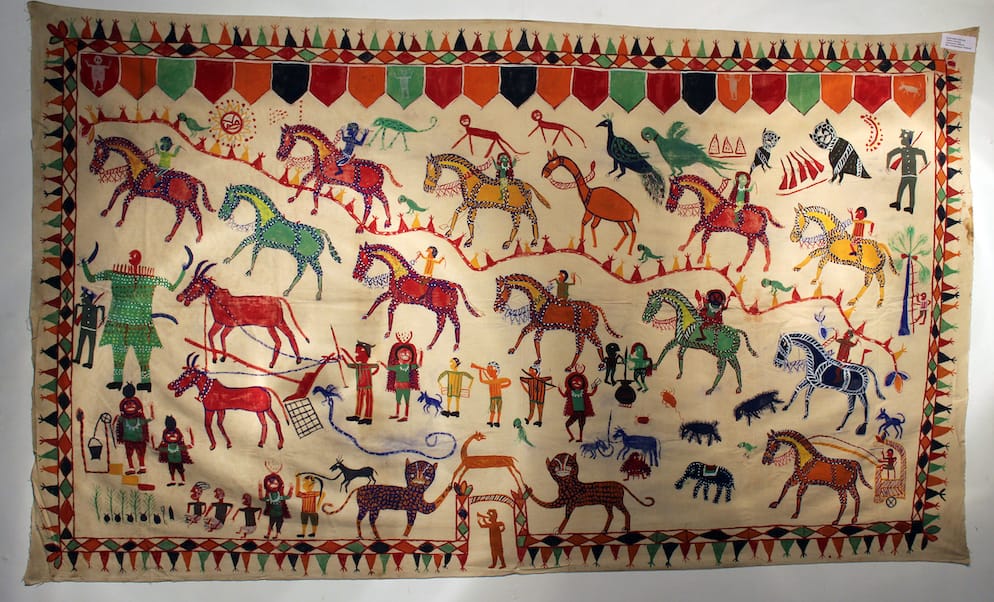
Origin and Cultural Context: Pithora painting is a ritualistic art form practiced by the Rathwa and Bhilala tribes of Gujarat and Madhya Pradesh. The paintings are created on the walls of homes to seek blessings from the gods and to mark auspicious occasions.
Techniques and Materials: Pithora paintings are made using natural colours, and the process is often collaborative, involving several members of the community. The paintings are created in a ritualistic manner, with each element of the composition holding symbolic meaning.
Themes and Motifs: The paintings depict a variety of themes, including deities, animals, and scenes from tribal life. The compositions are typically arranged in a grid, with the central figure of the god or goddess surrounded by other elements.
Cultural Significance: Pithora paintings are deeply connected to the religious beliefs of the tribes. They are created as a form of thanksgiving to the gods and are an integral part of the tribe’s spiritual and cultural life.
Kalighat Painting: The Urban Folk Art of West Bengal

Origin and Cultural Context: Kalighat painting originated in the 19th century around the Kalighat temple in Kolkata. Initially, it was a form of religious art, but it evolved to depict contemporary social issues and everyday life with a satirical twist.
Techniques and Materials: Kalighat paintings are done on cloth or paper using bold, sweeping brushstrokes and vibrant colours. The art form is known for its fluid lines and simple yet expressive depiction of subjects.
Themes and Motifs: While initially focused on religious themes, Kalighat paintings later began to depict scenes of everyday life, often with a humorous or critical edge. This shift made the art form an important vehicle for social commentary.
Cultural Significance: Kalighat paintings played a significant role in the social and political discourse of the time, using art as a medium to comment on social norms and injustices. Today, they are celebrated as an important part of India’s urban folk art heritage.
Bhitti Chitra: The Mural Art of Odisha
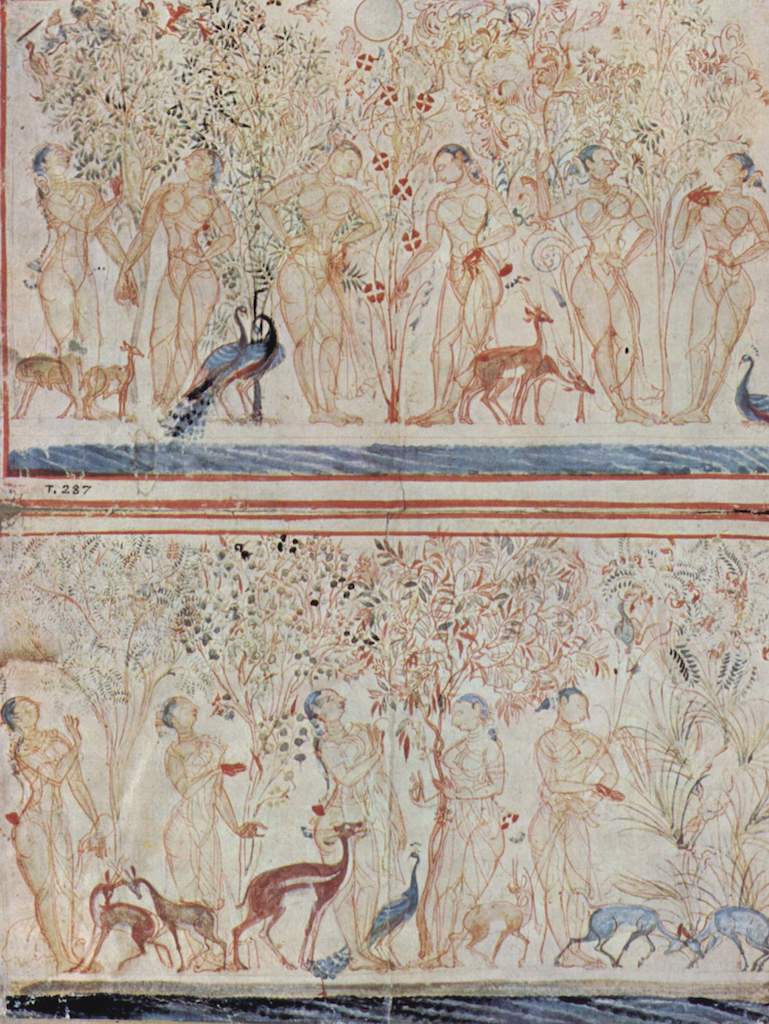
Origin and Cultural Context: Bhitti Chitra refers to the mural paintings found in Odisha, particularly on the walls of temples and homes. These murals are often created during festivals and depict religious themes, particularly stories from Hindu mythology.
Techniques and Materials: The murals are made using natural colours derived from minerals and plants. The artists create detailed representations of mythological stories, with vibrant colours and intricate designs.
Themes and Motifs: Bhitti Chitra often depicts scenes from the lives of Hindu deities, particularly Lord Krishna and Lord Jagannath. The murals serve as a visual narration of sacred stories, enhancing the spiritual ambiance of the spaces they adorn.
Cultural Significance: Bhitti Chitra is an integral part of the religious and cultural life in Odisha. The murals are created as an offering to the gods and are believed to bring blessings to the community.
Rogan Painting: The Textile Art of Gujarat
Origin and Cultural Context: Rogan painting is a unique textile art form from the Kutch region of Gujarat, known for its intricate designs created using castor oil-based paint. The art form was traditionally used to decorate bridal trousseaus and other textiles.
Techniques and Materials: Rogan artists use a metal stylus to create freehand designs on fabric using a thick, oil-based paint. The patterns often include floral motifs, animals, and intricate geometric designs.
Themes and Motifs: The designs in Rogan painting are typically symmetrical and highly detailed, reflecting the skill and precision of the artists. The motifs are often inspired by nature, with flowers, birds, and trees being common subjects.
Cultural Significance: Rogan painting is celebrated as a rare and intricate art form, with efforts being made to revive and preserve this tradition. The art form is not only a visual delight but also a testament to the craftsmanship of the artisans.
Cheriyal Scroll Painting: The Narrative Art of Telangana

Origin and Cultural Context: Cheriyal scroll painting is a traditional narrative art form from Telangana, closely linked to the storytelling traditions of the region. The scrolls depict stories from the Puranas, epics, and local folklore.
Techniques and Materials: The scrolls are made using khadi cloth, coated with a mixture of white mud, starch, and tree gum to create a smooth surface. The paintings are done using natural dyes and depict the stories in a sequential manner.
Themes and Motifs: Cheriyal scroll paintings often depict scenes from Hindu epics like the Ramayana and Mahabharata, along with local legends. The paintings are highly detailed, with each panel telling a part of the story.
Cultural Significance: Cheriyal scroll paintings are an important part of the local storytelling tradition, keeping alive the oral histories and cultural narratives of Telangana. The art form is celebrated for its detailed and colourful depictions of mythological stories.
Conclusion: Preserving the Legacy of Indian Folk Art
Indian folk art forms are a vibrant testament to the country’s rich cultural heritage. These art forms, passed down through generations, have survived the test of time and continue to thrive in the modern world. Whether it is the intricate patterns of Madhubani, the minimalist designs of Warli, the vibrant colours of Pattachitra, or the spiritual motifs of Gond art, each of these traditions offers a unique window into the lives and beliefs of the communities that create them.




